土木工程概论(2)讲课稿
- 格式:doc
- 大小:36.00 KB
- 文档页数:9
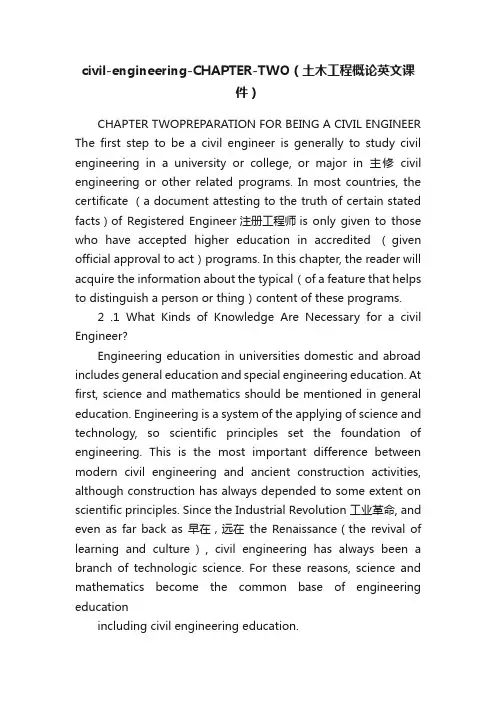
civil-engineering-CHAPTER-TWO(土木工程概论英文课件)CHAPTER TWOPREPARATION FOR BEING A CIVIL ENGINEER The first step to be a civil engineer is generally to study civil engineering in a university or college, or major in主修civil engineering or other related programs. In most countries, the certificate (a document attesting to the truth of certain stated facts)of Registered Engineer注册工程师is only given to those who have accepted higher education in accredited (given official approval to act)programs. In this chapter, the reader will acquire the information about the typical(of a feature that helps to distinguish a person or thing)content of these programs.2 .1 What Kinds of Knowledge Are Necessary for a civil Engineer?Engineering education in universities domestic and abroad includes general education and special engineering education. At first, science and mathematics should be mentioned in general education. Engineering is a system of the applying of science and technology, so scientific principles set the foundation of engineering. This is the most important difference between modern civil engineering and ancient construction activities, although construction has always depended to some extent on scientific principles. Since the Industrial Revolution 工业革命, and even as far back as早在,远在the Renaissance(the revival of learning and culture), civil engineering has always been a branch of technologic science. For these reasons, science and mathematics become the common base of engineering educationincluding civil engineering education.Owing to the accumulation of several centuries, modern science has accumulated. a massive(containing a great quantity of matter)body of literature and knowledge.However, the beginner need not sit under apple tree to discover the laws of universal gravitation as Isaac Newton did in legend(a story about mythical). Neither does he have to exhaust (wear out completely)his brain for the principle of transform between energy and the mass. Based on the work of numerous pioneers, new students can now enter into the paradise of science easily. Nowadays, engineering is a synthetic system not only depending on traditional mechanics, but also closely relating to advanced science. You can find the courses such as Physics, Chemistry, Computer Science, Material Science, Environmental Science, and perhaps more, in your civil engineering program.One characteristic of modern science is that it can be described exactly and beautifully by mathematics. So the engineer should grasp this powerful tool to solve the problems they will meet in engineering analysis, design, planning and control. In this aspect, engineering students should learn advanced mathematics高等数学including analyticgeometry解析几何;分析几何学(the use of algebra代数学to study geometric properties);, differential and integral calculus 微积分, progression, differential equation微分方程(an equation containing differentials of a function). In addition, study of linear algebra线性代数, matrix, probability, numerical methods数值方法;计算方法is usually required by Civil Engineering Program. Using all of this knowledge, an engineer is able to predict preciselyimportant things about the project. For example, an engineercan tell whether a house or a bridge is safe or dangerous when earthquake occurs, or when it is hit by a hurricane. How can the skilled engineer do it? The engineer does this by using abstract models from physical objects(物理对象visible entity), which can be described and predicted by mathematics. Mathematics数学运算provides engineers with a solid foundation in their engineering activities. Furthermore, by strict training through verification确认,查证;核实(additional proof that something that was believed (some fact or hypothesis or theory) is correct), deduction推论(something that is inferred)and calculation in the study of mathematics, one will accustom oneself to logicality, strictness, and more rationality; important qualities for a good engineer.An engineer not only just takes the responsibility or the technology and production activities of a project but also has the duty to the society. Does your engineering project benefit your people and society or harm them? A qualified engineer should be conscientiously aware of this point at all times and for this reason universities also organize social science and humanities education for their students. Students enrolling in engineering programs should accept the education in this aspect. Philosophy, ethics, history, literature, aesthetics(the branch of philosophy dealing with beauty and taste (emphasizing the evaluative criteria that are applied to art), as well economics, management (the act of managing something)and foreign language are a useful and necessary tool.The necessary knowledge for professional occupation of civil engineering is composed of two parts; base knowledge for entire civil engineering and corresponding knowledge for a special aspect.Most civil engineering projects can be seen as varieties of structures. In order to ensure the safety of structures, civil engineers should understand their mechanical properties力学性能, such as forces, stresses (force that produces strain on a physical body), displacements (move something from its natural environment)and deformations(the act of twisting or deforming the shape of something)of the structures, caused by the weight of the structure itself and facilities, winds on the structure, vehicles车辆, varying of temperatures, and perhaps earthquakes. Courses, usually named mechanics of materials材料力学, structural analysis结构分析, elasticity(the tendency of a body to return to its original shape after it has been stretched or compressed), are set for this purpose. Because civil engineering projects are laid on or under the ground, to know soil and rock properties well is necessary. Thus geo-engineering, soil mechanics and foundation studies are also base knowledge. Water and wind, those will act on or react with the structures, have common properties in the view of mechanics, and fluid mechanics流体力学(study of the mechanics of fluids)deals with the concerned theories. Furthermore, a knowledge of engineering chart drawing (a skill to express the design idea by pictures in common rules understood by engineers* technicians and workers), surveying(to measure the landform for construction), and electricity, machinery, construction management建筑工程管理and general technic, budget(a sum of money allocated for a particular purpose), bidding投标;出价(the number of tricks a bridge player is willing to contract to make)the tendering are also required.绘制应力应变图Since civil engineering covers many fields of knowledge with many aspects which will be found in the rest chapters of thisbook, it is impossible to learn all of the knowledge in these areas. Almost all of the universities in the world to provide students with several options to enable them to specialize专门研究in the fields mentioned in Chapter One. Such a method is also being re-accepted by civil engineering education in China since 1998 although it was the way in the early history of higher civil engineering education before 1950s. For example, students can now choose options in building structures, bridge, tunnel, road pavement and construction, railway and so on, to know how to design, construct, and organize a civil engineering project. And the students are usually encouraged to choose more options for their future professional life.You can choose one of them as your direction2 2 What Can the University Education Provide for Students?COURSES: Basically, university offers students a variety of courses. The branches of knowledge mentioned above are involved in the courses and courses are usually divided into three types: requirement anything indispensable, approved electives批准选修, and free choice.The requirement and approval electives are both the courses that the students majored in must learn. There are some differences between the two types. Students can not miss any requirement course while have limited right to elect some of the approved electives. In that case那样的话a university usually tells students the minimum which they should choose in the list of the approval electives. As for关于the free choice, universities normally ask for a necessary number of credits or class hours. Those who hope to graduate and be awarded the corresponding degree, have to meet the requirement of the university or the school.Universities should continually adjust teaching plans and course tables 课程表with the development of science and technology, to meet the needs of future engineers. So the contents of courses are changed from time to time.TEACHERS: As in middle and high schools,teachers in universities give lectures, check homework, organize panel discussion专题讨论会(discussion of a subject of public interest by a group of persons forming a panel usually before an audience) for special problems, guide the students to experiments and also check answers in test sheets at the end of semester.Simultaneously, most of them play the role of scientists and/or engineers. They publish research papers研究论文in journals, spend much time in laboratory to verify a new discovery, test a renewal material with the engineering purpose, or design and make a new tool for engineering purpose. Some of them are registered engineers注册土木工程师if their field is civil engineering, and even have their own design institutes. In famous universities, when you knock a door to ask your professor a question, you will be probably told that the professor who you are talking is a respectable academician of Academy of Sciences orEngineering. The groups of wisdoms, who are good at theories and practice experience, are the best gift the universities afford to the students. Unlike the teachers in middle and high schools, university professors rarely monitor your daily study, because they appreciate students should study on individual initiative.With the development of internet, the tele-course is becoming fashionable. A young student will be in a puzzle about the large number of teachers in one university, but will find, faceto face lecture and discussion is always charming, and direct communication not limited in speech. Communication is also by means of expression of teacher's eyes and gestures. The close distance between you, your classmates and the lecturer, will make for an excited atmosphere, it is why since Socrates苏格拉底(古希腊哲学家)(ancient Athenian philosopher; teacher of Plato and Xenophon (470-399 BC), Confucius孔子(中国哲学家,教育家)(Chinese philosopher whose ideas and sayings were collected after his death and became the basis of a philosophical doctrine known a Confucianism (circa 551-478 BC), no matter how modern the society has become, and no matter what kind of high tech is introduced into the education process, the university always keeps its campus and excellent scholars学者们in a remarkable size.LABORATORY AND SITE PRACTICE BASE: For engineering colleges, the laboratories equipped with variety of test machines and measuring devices, and opened to students are indispensable. There are several types of experiments with special purpose, for demonstration, observation, validation确认;批准;生效(the act of validating; finding or testing the truth of something), practical training实习训练, exploration探究(a careful systematic search), or others. The basic experimental skill necessary for engineers can be learned in the laboratories. Most of test items测验项目are specified in the textbook, and detailed instruction is printed. In recent years, universities in China encourage students to design the experiments themselves, and do what they are interested in the related fields, to make students have the desire for innovation.It is cognized that a qualified engineer should possess rich experience obtained from engineering practice, so practicalexercise becomes one important part of the education plan of civil engineering program. Laboratory training is part of this practical training.Others are design work both in classroom and in workroom of consulting companies or design institutes, construction site work, geologic investigation地质勘察, surveying and measurement outside. In most cases Chinese universities, set practice bases at construction companies and design institutes. Usually students are requested to join the construction site work during the summer or winter vacation. A new procedure is tried in a few universities to ask students to search the projects being constructed and go there for their practical training. The procedure itself is taken as a practice. Most universities take the practical trainings to be requirement or approved electives.LIBRARY AND OTHER INFORMATION SOURCES: Self-study is a typical mode of university students. Successful students are always those who do not satisfy the contents of lectures and homework given by teachers. For themcomprehensive reading is undertaken outside indicated textbooks. Books, journals, reports and dissertations学位论文in the form of collection of printed pages打印页面which are stored in the book shelves are also read. Of course, the libraries in modern universities are reformed with the computer system and network, and the electronic libraries make it more convenient for students more convenience to borrow and read. The ability to search, find, and grasp information becomes more and more important in this age, and it is the task of the university education to let students have this ability.SPIRIT AND ATMOSPHERE: In the common sense, the universities are the place where there are freedom for thinking,equality in academy, and advocation of creation. Furthermore, the alternation of new students every year, make university campuses full of the energy of the younger generation.New student military trainingACTIVITIES OUT OF CLASS: there are different student organizations in the campus that help connect classroom to career, develop professionalism, increase technical proficiency, and refine ethical judgment. For example, the Institute of Civil Engineers (ICE) of British welcomes the students enrolled in program of civil engineering to be student members; even ICE develops its members in Chinese universities.Recently American Society of Civil Engineering ( ASCE) joined this action too. There are many sports teams for soccer, basketball, badminton, swimming, track and field, which are organized inter-class, department and even college. Societies in literatures and arts, will afford students a total different area from those in the class.2.3 What Abilities Shall a Future Civil Engineer Possess?THE ABILITY TO APPLY THE KNOWLEDGE:Elementary knowledge is essential to a civil engineering student. In common, by four-year period study, the student should be proficient熟练的,精通的in mathematics through differential equations 微分方程, probability and statistics概率论与数理统计, calculus-based physics微积分学, and general chemistry普通化学; proficiency ln the material mechanics材料力学, fluidmechanics流体力学, structural analysis and geo-techknowledge? good command of theprimary skills for engineering survey, drawing, test, and calculation and design, and at least deeper understanding several major civil engineering areas.The emphasis should be shifted to the application of the knowledge after we understand the importance of the knowledge. 'To know' is mere the first step. For engineers, the more important thing is to apply his knowledge i.e. natural science, mathematics and elementary engineering knowledge recorded in the textbooks or papers in the form of rules, principles, formulae and data, to solve engineering problems.THE ABILITY TO CONDUCT EXPERIMENTS AND EXPLAN THE RESULTS: The ability to plan and conduct experiments and analyse the results are basic aspects of the engineer's abilities.The future engineer is required to conduct laboratory experiments and to critically analyze and interpret data. Though many problems can be solved efficiently and economically by computation in a fine mechanical model, it is not everything. When new material or new structural system is used in civil engineering project, there are new variables which are not reflected, covered in the ready-made model. It will be dangerous if engineers do not change their mathematical model in time. However, how to calibrate the model? The most practical way is to do an experiment. Similar things also encounter in built-up or 'older' constructions, because there are many unknown factors. For example, material used in the structure will weaken, be damaged and lose its function through the duration of a structure's life while the change cannot usually be fully expected at the beginning. And on the other hand, the surroundings, conditions and real loads can also change. Engineers and researchers make the same phenomena, in most case, to recur (happen or occur again) in the laboratory, so that they can reveal the mechanism which now should be understood for the purpose of the safety of the structure. Though according to the basetheory, research engineers are able to judge the results of the experiments, it is common that the observed phenomena or obtained data in the experiments conflict with the known knowledge. In this case, the conflict will bring new discovery and improve an engineer's work. Give a rational explanation to a seemingly strange phenomenon is a wonderful task. It needs to synthesize knowledge of many subjects and to create new knowledge which is not mentioned or recorded in the literature.THE ABILITY OF DESIGN: For engineers, the ability to design a system, a component- or a procedure of construction is basically required. Civil engineers are creating substantial entities every day and everywhere in the world. Before they make them,they should be 'described'. It is the description of the non-existed entity that is called 'design'. The design shows what the future project is, and how to make it in a language which can be understood by constructors. The engineering design is quite different from the design of a piece of artwork, though we sometimes hear the admiration for a building as 'a graceful sculpture'. However, an artist can make a sculpture horse supporting only by one hoof, it will be impossible at ten times the size because the weight increases in three power of the size. Here the key factors will be functionality, safety and low-cost. It means that only the design which meets this requirements is practicable. So the engineering design work should obey the codes, specifications and guidance which arebased on scientific principles and the summary of accumulated experience. On the other hand, as an enterprising engineer. he or she never satisfies the existed ways or technics, so to search a possible way under the limited conditions to realize the 'impossible' things in design will be a challengeable butcharming work forever.THE ABILITY TO COOPERATE WITH WORKING TEAM: An engineer never work alone. Each project is a system, so the design work involves many people' efforts. For a big size building structure, the structural engineers should work with other experts from different disciplines, such as architects, surveyors, mechanical engineers and electricians. In the past, a skilful engineer would play several roles in a project with small size, but nowadays the different jobs should be taken by qualified engineers possessing certificates. When you are in the position of chief engineer in the work team, you should be in more harmony with your fellows. in order to cooperate with others well, every engineer should know how to hear and understand others, to consider things in both sides, you and your fellows, and to make necessary concession after discussion or even quarrels.THE ABILITY TO COMMUNICATE EFFECTIVELY:This is the ability which is an engineer should pay more attention to in the modern society. T o the engineer, as a designer, you should let your clients to accept your design, recognize that what you designed is the most suitable one in many possibilities; you should let the examiners and officers from government believe that your design accords with the low and specification so that the public and surroundings are safety? and you should let the contractors, manufacturers and construction companies understand your consideration and its rationality and feasibility. After being an engineer, you will find that you are frequently asked to attend meetings, to explain something for the project you designed, and you have to go to the construction site to hear new problems and tell the technician the answers. All of these need good communication unfortunately, until now our highschools and universities gave few chances to most of students to train their communication skills. Young engineering students now should take this seriously, and make great efforts to improve their communication ability.The basic element of communication is to speak. So try to look on your audience, no matter in seminars, in meetings or even in your friends' parties, make your voice loud, speak clearly and use plain but vivid vocabulary as possible.Besides speaking, the effective communication includes writing skill and expression of one's idea both in pictures and simple formulas. There are many skills you should learn, but the most important thing is to remember that the purpose of effective communication is for thoroughly understanding between you and your companion.Communication is not the same thing performing on a stage, where the key point should be exchange of information successfully. Good communication skill also includes hearing and considering companion's opinion. Discussion is also involved in the process of communication.2.4How Do You Match the Demands of the Program Education?Through four-year-period study to make yourselves acquire basic knowledge and training for being an engineer is one of the main targets that makes you enter into a university and enroll into a special engineering program.University is a new circumstance to freshmen students. For those who just left high school, and perhaps many of them are first time to sleep in dormitory of school, they should he familiar with the new life as early as possible.STUDY IN CLASSROOM: Needless to say, study is the mostimportant task. There are many things to 'study'. However, to study and understand the knowledge which are necessary for the education objectives as introduced previously in this chapter and specified by the program, education plan is the basic requirement.As a student, you have had the school experience more than ten years, so you know the study skill well; reading textbooks, attending the lectures, taking noteswhen listening, doing homework ............... .. those are almost the same as in high schools. But something changes.The engineering students usually do not have their fixed classroom. They should move from one building to another during the ten minute break between classes. Nobody shares one standard curriculum schedule with his classmates in the same program, especially in the junior and senior year. Students have the opportunity to choose what they 'prefer', and every one shall type the number of the course he wants to join in the next semester into the computer registered system, or after a long queue outside the administration office to fill in course register form. To Chinese students, the most difference from the traditional high school is perhaps that no teacher will strictly monitor your daily study life.Are you free? Certainly. But, just to certain extentSame as the other programs, the Civil Engineering Program requires necessary credits before you are approved to graduate from the university. Each course has its credits according to the class hours and the importance. After passing the examination, you can obtain the pointed credits. If the program asks its students to fulfill total 150 credits, you will never expect to be awarded the engineering bachelor degree in the case that youearned only 149 credits! Furthermore, as you have known, the courses you have to take are divided into three types, requirements, approval electives and free choice, but to each of the three types, the program education plan specifies a certain amount of credits you have to obtain. That is to say your freedom is not infinite.Sometimes, a student will be informed that he did not meet the requirement of the program because he does not pick enough credits in approval electives indicated by the program education plan. So, students had better to read program education plan and student manual carefully once enrolling in the program, and to follow it in the following days. What your tutor who is designated by the department for you, if any can do is to give you some suggestion or advice when you consider to choosesomething.To finish all the courses the program asks is important, and to get high points is encouraged. When you pursue advanced degree study, or apply for a good position1)i n your career life after graduation, high points are always helpful at the beginning. However, good students are not those who only know the description printed on the books or recite the formulae, but fail to explain practical phenomenon,to discover unknown things and to have strong motivation to create new knowledge himself. So university professors encourage students to consider problems in different views, and appreciate students to observe in their own eyes and to ask questions after thinking.JOIN ACTIVITIES IN CAMPUS OUT OF CLASS ACTIVELY: Since an engineer needs to learn effective communication with othersand smooth cooperation with work teams, and to be a good fellow and a success leader both in engineering and social activities, engineering students ought not to localize their 'study' only in academy or pure specialty. Fortunately, a university is such a school that provides with plenty of opportunities to those who would like to develop their multi-talents so that campus activities are called the 'amateurish classroom'. To join one or several activities which attract you in variety of campus activities, i.e. sports, drama and concerts, forums, competitions, clubs and reading party, will benefit your spirits and brain, enlarge your friend circle and get a way more comfortable to develop yourself. It is the university tradition to encourage students to join campus activities.PERSIST IN PHYSICAL EXERCISE: It is not a special requirement to civil engineering program students. Keeping in good health makes people to have confidence to live and work, to ensure the engineers energetically devote themselves into heavy work. By the way, though it is said not to work too heavy, in fact the work of civil engineers is really a heavy one, considering the duty engineer must take for the safety of human being and the society!Universities seek two main achievements in this aspect: to let the daily physical exercise become one of the personal customs of students and to train students to have some basic skills for physical exercise. Both of these are indispensable preparation for a qualified engineer.BE AWARE OF SOCIAL RESPOSSIBILITY:了解社会责任Why has society established a register engineer system, and why has this system been widely accepted by most of the industrial countries? The answer is that each engineering project that engineersinvolved in is not only a solution to a pure technical problem. At first, it will relate to the safety of life and estate. The failure of a building, collapse of a bridge or even a serious accident when undergoing construction may induce a real catastrophe to people, and make the loss of life and estate. So society asks that engineers who take the technical responsibility to the projects must be those who are qualified in knowledge and abilities. The procedure to cognize the candidate's qualification in engineering is the matter of register engineer system.With the development of natural and social science, people have more comprehensive understanding to human being and the relation with the world. In such a background, engineers should consider more and take larger responsibilities. The engineers are being required to understand the relation of his engineering projects with the society, and theinfluence of the projects on environment and continuous development. For example, if an industry building to be built will bring high benefits to investors, but also high risk to pollute the rivers and surrounding soils, what should the civil engineers do? The civil engineers shall be aware of the responsibility to cooperate with the experts in that field to solve the problem. In that case, a structural engineer may adjust the previous concept design if necessary.To be a responsible and conscientious engineer, the engineering student in the university should leave himself enough time to contact comprehensive knowledge about ethics, history and cultures of the different construction regions, beyond engineering subjects. The student needs to develop fine personality. A selfish person will be difficult to be a good engineer.。
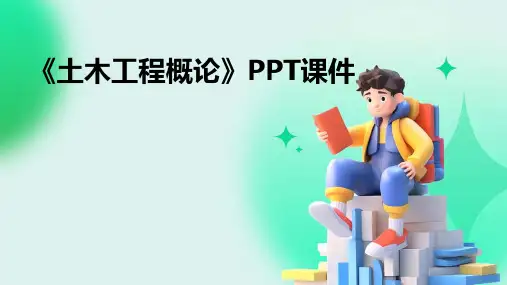
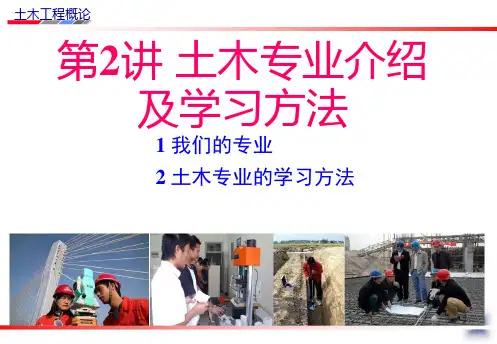


《土木工程概论》课程教案第一章土木工程概论土木工程的内涵土木工程的定义:土木工程需要解决的问题•人类生存的需要(空间、通道、环境等)目的•抵抗自然灾害、人为破坏存在原因•充分发挥材料的作用物质基础•土木工程施工与组织管理最终归宿土木工程具有四个基本属性•社会性随社会不同历史时期的科学技术和管理水平而发展•综合性综合应用多种工程技术,进行勘测、设计和施工的成果•实践性影响因素多、复杂,对实践依赖性强•技术、经济和艺术的统一性。
古代土木工程特点:天然材料为主:泥土、砾石、树干、树枝、竹、茅草、芦苇、土坯、加工后石材、砖、瓦、木、青铜、铁、铅以及混合材料,如草筋泥,混合土;工艺技术简单:早期用石斧、石刀,后有人工打造的斧、凿、钻、锯、铲等青铜和铁制工具,逐步产生了窑制和煅烧加工技术,以及打桩机、桅杆起重机等施工机械;分工逐步专业化:木工、瓦工、泥工、土工、窑工、雕工、石工、彩画工等;经验总结和形象描述为主,理论依据缺乏。
土木工程直接与人们的衣、食、住、行密切相关,是一门古老的学科,但是它伴随着其他相关领域学科的发展、经济建设和社会进步的需要不断深化,不断拓展。
•建国以来的基本建设实践告诉我们,违反建设程序,疏于管理,工程就会出乱子,甚至会带来不可挽回的重大损失。
土木工程建设的复杂性和特殊性,更要求我们建立和完善的建设法规,严格按基本建设程序办事,科学统筹,严格管理,在国家宏观调控的前提下,形成市场化运作为主的机制。
建设程序•建设程序是指建设项目从设想、选择、评估、决策、设计、施工到竣工验收,投入生产的整个建设过程中,各项工作必须遵守的先后次序的法则。
这个法则是人们在认识客观规律的基础上指定出来的,是建设项目科学决策和顺利进行的重要保证。
•建设项目的组成:建设项目、工程项目、单位工程、分部工程、分项工程;建设程序步骤建设程序基本内容•(1)项目建议书阶段项目建议书是要求建设某一具体项目的建议文件,是基本建设程序中最初阶段的工作,是投资决策前对拟建项目的轮廓设想。
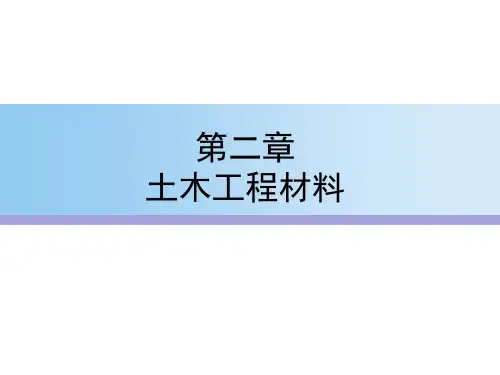

第一章绪论一、学习重点(一)基本概念1.土木工程:土木工程是建造各类工程设施的科学技术的总称,它既指工程建设对象,即建在地上、地下和水中的各种设施,也指所应用的材料、设备和所进行的勘察设计、施工、保养、维修等技术。
2基本建设:国家将工厂、矿井、铁路、公路、桥梁、农田水利、商店、住宅、医院、学校、给水排水、煤气输送、输变电等工程建设称为基本建设。
3.信息化管理:在基本建设管理过程中所涉及的勘察设计、施工、保养、维修等技术广泛运用计算机信息技术,对质量(原材料、设计、施工)、进度(工期、人员和机械调配)、造价(人工、材料、机械)和资金成本运作等信息进行收集、储存、处理和交流,并加以科学地综合利用,为基本建设管理及时、准确地提供决策依据。
4.可持续发展:是指既满足当代人的需要、又不对后代人满足其需求的发展构成危害。
(二)基本知识和基本概念1.土木工程概论课程的任务“土木工程”包括哪些内容?“土木工程”专业的学生主要学习哪些知识、掌握哪些基本技能、具备哪些能力?怎样才能学好“土木工程”?回答这些问题就是本课程的基本任务。
土木工程的内容非常广泛,它和人民群众的日常生活密切相关,在国民经济建设中起着非常重要的作用。
土木工程的范围包括房屋建筑工程、公路与城市道路工程、铁路工程、桥梁工程、隧道工程、机场工程、地下工程、给水排水工程、港口工程、码头工程等。
2.土木工程需要解决的问题第一个问题是为人类活动需要(既有物质方面的也有精神方面的)提供功能良好、舒适美观的空间和通道,同时还表现为防水患、兴水利以及环境治理等方面。
这是土木工程的根本目的和出发点。
第二个问题是抵御自然灾害或人为作用力。
前者如地震、风灾、水灾等作用,后者如工程振动、人为破坏等。
第三个问题是要充分发挥材料的作用。
因为材料问题是建造土木工程的根本条件;从古到今,任何土木工程都是由工程材料如土、石、砖、混凝土、钢材、木材、合金材料、工程塑料等按稳定的几何形状和尺寸堆砌建造起来的。
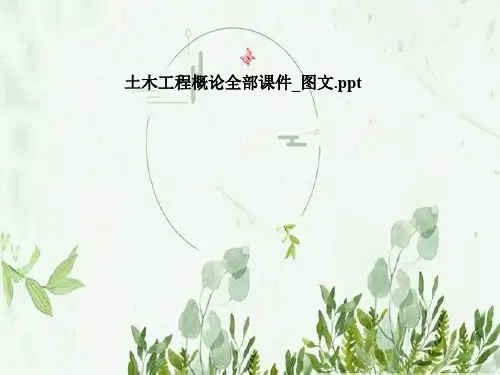
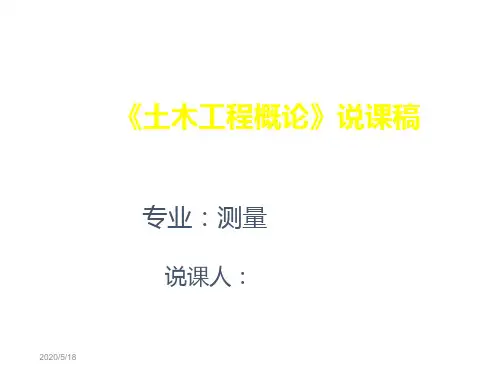
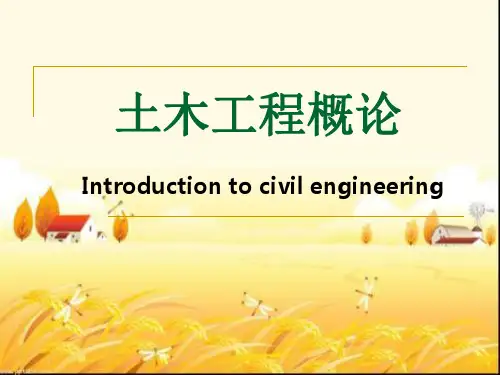
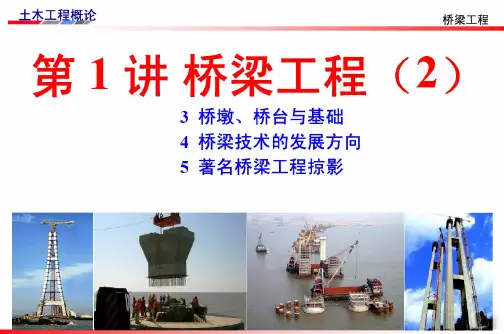
第一章绪论一、学习重点(一)基本概念1.土木工程:土木工程是建造各类工程设施的科学技术的总称,它既指工程建设对象,即建在地上、地下和水中的各种设施,也指所应用的材料、设备和所进行的勘察设计、施工、保养、维修等技术。
2基本建设:国家将工厂、矿井、铁路、公路、桥梁、农田水利、商店、住宅、医院、学校、给水排水、煤气输送、输变电等工程建设称为基本建设。
3.信息化管理:在基本建设管理过程中所涉及的勘察设计、施工、保养、维修等技术广泛运用计算机信息技术,对质量(原材料、设计、施工)、进度(工期、人员和机械调配)、造价(人工、材料、机械)和资金成本运作等信息进行收集、储存、处理和交流,并加以科学地综合利用,为基本建设管理及时、准确地提供决策依据。
4.可持续发展:是指既满足当代人的需要、又不对后代人满足其需求的发展构成危害。
(二)基本知识和基本概念1.土木工程概论课程的任务“土木工程”包括哪些内容?“土木工程”专业的学生主要学习哪些知识、掌握哪些基本技能、具备哪些能力?怎样才能学好“土木工程”?回答这些问题就是本课程的基本任务。
土木工程的内容非常广泛,它和人民群众的日常生活密切相关,在国民经济建设中起着非常重要的作用。
土木工程的范围包括房屋建筑工程、公路与城市道路工程、铁路工程、桥梁工程、隧道工程、机场工程、地下工程、给水排水工程、港口工程、码头工程等。
2.土木工程需要解决的问题第一个问题是为人类活动需要(既有物质方面的也有精神方面的)提供功能良好、舒适美观的空间和通道,同时还表现为防水患、兴水利以及环境治理等方面。
这是土木工程的根本目的和出发点。
第二个问题是抵御自然灾害或人为作用力。
前者如地震、风灾、水灾等作用,后者如工程振动、人为破坏等。
第三个问题是要充分发挥材料的作用。
因为材料问题是建造土木工程的根本条件;从古到今,任何土木工程都是由工程材料如土、石、砖、混凝土、钢材、木材、合金材料、工程塑料等按稳定的几何形状和尺寸堆砌建造起来的。
土木工程概论(2)第二章1、列举有代表性的采用不同建筑材料的典型建筑。
木材:北京故宫,湖北黄鹤楼;石材:中国长城,埃及金字塔,巴黎凯旋门,巴黎圣母院,法国凡尔赛宫,英国白金汉宫,德国科隆大教堂;钢筋混凝土:中国人民大会堂;钢材:北京奥运会鸟巢,巴黎埃菲尔铁塔,北京水立方2、绿色建材全面系统研发的含义。
我国建筑和建材产业面临资源、能源和环境的压力,存在着建筑围护结构保温性能差、建筑工程材料生产和应用脱节、建筑设计选材难、新型建材产品推广使用难等问题。
在目前形势下,提高建筑中采用绿色建筑材料和产品的比例、促进建筑垃圾再生利用尤为重要,研究、开发和应用环境友好型建筑材料与系列产品具有重要意义。
第三章1、比萨斜塔的基础形式。
筏板基础2、比萨斜塔产生倾斜的主要原因。
由于地基不均匀沉降和土地松软而倾斜3、基础有哪几种形式?分别适用于何种情况?1.条形基础:多用于单层或多层砌体结构;2.独立基础:多用于框架结构或单独柱子的情况;3.井格式基础:当地基条件较差,为了提高建筑物的整体性,防止柱子之间产生不均匀沉降,常将柱下基础沿纵横两个方向扩展连接起来,做成十字交叉的井格基础;4.桩基础:当浅埋基础不能满足地基强度和变形要求时采用;5.筏基础:常用于地基软弱的多层砌体结构、框架结构、剪力墙结构的建筑,以及上部结构荷载较大且不均匀或地基承载力低的情况;6.箱形基础:用于上、对地基不均匀沉降要求严格的高层建筑、重型建筑以及软弱土地基上多层建筑时;部建筑物荷载大。
4、防止地基不均匀沉降的措施有哪些?1在设计时候尽量使上部荷载中心受压均匀分布2遇到高低相差悬殊或地基软硬突变时,要合理设置沉降缝3增加上部结构对地基不均匀的协调作用。
如在砌体结构中设置圈梁以增强结构整体性。
4合理安排施工工序和采用合理的施工方第四章1、建筑物的基本构件有哪些?他们在建筑中中承担作用和可能的形式。
P622、大跨度建筑的结构形式有哪些?各有什么特点?P663、墙体承重有哪几种方式?他们有什么优缺点?墙承重有横墙承重、纵墙承重、纵横墙混合承重三种。
横墙承重方案:适用于房间的使用面积不大,墙体位置比较固定的建筑。
横墙承重的建筑物整体刚度和抗震性能较好,立而开窗灵活,但平面布置和房间划分的灵活性差。
纵墙承重方案:适用于房间的使用上要求有较大的开间,墙体位置在同层或上下层之间可能有变化的建筑。
在纵墙承重方案中,由于横墙数量少,房屋刚度差,应适当设置承重横墙,与楼板一起形成纵墙的侧向支撑。
纵横墙承重方案:适用于房间变化较多的建筑。
结构方案可根据需要布置,房屋中一部分用横墙承重,另一部分用纵墙承重,形成纵横墙混合承重方案。
此方案建筑组合灵活,空间刚度较好,墙体材料用量较多,适用于开间、进深变化较多的建筑。
4、高层超高层的结构形式有哪些?P72第五章1、查阅中国公路网,了解我国公路现状。
2、检索国内里程长度最长的前五条铁路。
3、任选一国家的首都机场和我国首都机场作定性比较。
列举隧道开挖中的安全防范措施。
1软弱围岩、不良地质、特殊地质或浅埋、偏压、滑坡地段隧洞,应组织技术论证,确定钻爆、掘进、支护方案。
2 洞内通风管、高压风管、水管、照明线、输电线、运输道路、人行道路要统一规划,加强维修,做到布设整齐,状态良好。
机械设备要固定存放位置,料具堆码整齐,专人负责保管。
3洞内施工应由值班领工员统一指挥,按施工组织设计合理安排开挖、衬砌和运输作业,减少交插和相互干扰。
4爆破开挖应做出爆破设计,采用光面爆破或预裂爆破技术必须严格控制周边眼间距、外插角和装药量等参数,减少对围岩的扰动及超欠挖数量。
5爆破起爆后,应派专人进行检查,处理危石、悬石,并设人监护。
确认安全后,其他人员方准进入作业面。
做好洞内防尘,降低粉尘浓度。
5、高速公路的设计要求有哪些?并试述高速公路的优缺点?P92第六章1、列举五个国内外著名桥梁及其所采用的结构形式。
卢浦大桥钢拱结构苏通大桥斜拉桥武汉长江大桥连续钢桁架梁金门大桥悬索桥悉尼港大桥钢桁架拱桥2、决定桥梁跨度和高度时主要考虑的因素。
P1243、桥梁工程设计的要点有哪些?P124第七章1任选一港口城市,为它的建设和发展提出建议第八章1、结合美国波士顿地下空间的开发利用,阐述我国三大城市(北京、上海、广州)在进行城市开发与城市改造过程中,可采取哪些措施?2、我国地下能源开发的前景和可能遇到的困难。
3、发展地下工程的意义?1、为人类的生存开拓了广阔的空间。
2、地下空间具有恒温性、恒湿性、隔热性、遮光性、气密性、隐蔽性、空间性、安全性等优点。
3、社会、经济、环境等多方面的综合效益良好。
4、节省城市占地、节约能源、克服地面各种障碍改善城市交通、减少城市污染、扩大城市空间容量、节省时间、提高工作效率和提高城市生活质量。
第九章1、从科学发展观的视角,谈我国的防洪抢险工作的展开。
2、水电、火电、核电的利弊分析与比较。
水电要有水位落差的地方,地理位置受限制比较多,对环境有一定影响,还算比较环保。
火电有燃料就可以,但是污染严重。
核电清洁安全,且发电功率大,但是对设备要求很高,投资大。
3、水力发电在我国电力工业中的地位和发展前景。
水力发电在我国电力工业中的位置很重要,其装机总容量位于火力发电以后,为第二位。
主要作为区域供电和调峰电站使用,个别超大容量电厂也跨区域送电P178第十章1、城市节水的途径探索。
1、冷却水的重复使用:在工厂推行冷却塔和冷却池技术,可使大量的冷却水得到重复利用,并且投资少,见效快。
2、回收利用废水,建立工业用水的封闭循环系统3、循环用水:在化工、电镀、印染、纺织等行业的生产过程中,可推行逆流漂洗的循环用水技术。
4、革新工艺,采用新技术:以风冷却、汽冷却代替水冷却,以热水代替蒸汽采暖。
2、城市污水处理政策机制的初步研究。
3、城市给水系统有哪几种,各自的优缺点是什么?P1914、城市排水体制有哪几种,各自的优缺点是什么?P196第十一章1、近三年来土木工程施工的新技术。
无梁楼盖,空心薄壁管2、奥运体育场馆建设中的有关施工的报道。
3.简述土方工程施工要点。
主要解决土壁稳定施工排水流沙防治填土压实4.简述砌筑工程施工要点。
P2145.简述钢筋混凝土工程主体施工要点钢筋绑扎,箍筋间距,保护层,浇筑施工注意接缝处理,灌注高度,钢筋搭接位置及长度,焊接的遵照规范6.简述施工组织设计的内容、分类。
P234第十二章现代化的项目管理具有哪些特点?1)项目管理的全球化发展。
(2)关于项目管理的多元化发展。
3)项目管理的专业学科发展。
一般大中型项目从建设前期到投入生产要经过几个阶段?前期工作阶段建设实施阶段竣工验收阶段施工方项目管理的主要任务是什么?施工安全管理施工合同管理施工信息管理施工成本控制施工进度控制施工质量控制与施工方有关的组织与协调试述施工总承包的特点?1、工程造价特点:部分施工图设计完成后,即可进行部分施工招标,确定相应的合同价,分包合同价比较准确;对施工总承包管理方的招标只确定总包管理费,无合同总造价,故合同总造成价是业主的一种风险;如果业主与分包商签约,还加大了业主的风险。
2、工期进度特点:施工总承包管理模式的招标不依赖于施工图纸出齐,可以就分包项目提前招标、开工、缩短建设周期。
3、质量控制特点:施工总承包管理方负责分包项目的质量控制;各分包合同交界面的协调控制也由施工总承包管理方负责,由此减轻业主工作量和管理负担。
4、合同管理特点:如果所有分包合同的招标、合同谈判、签约工作都由业主负责,则业主的合同管理工作量大,对业主不利。
反之则可减轻业主的负担。
相应的,对分包工程款的支付也有总承包管理方支付和业主支付两种方式,前者对总承包管理方管理分包商更为有利。
5、组织协调特点:施工总承包管理方要负责对所有分包商的施工管理及组织协调,大大减轻了业主的工作。
但是,如果分包合同都由业主签订,又会在一定程度上削弱施工总承包管理方对分包商的管理。
试述施工总承包管理的特点?一样施工总承包管理模式与施工总承包模式相比有哪些优点?1合同总价不是一次确定,某一部分施工图设计完成后,再进行该部分施工招标2有分包合同都通过招标获得有竞争力的投标报价,对业主方节约投资有利3施工总承包管理单位只收取总包管理费,不赚总包与分包之间的差价试述施工总承包管理的特点1.投资控制方面一部分施工图完成后,业主就可以单独或与施工总承包管理单位共同进行该部分工程的招标,分包合同的投标报价和合同价以施工图为依据。
在进行对施工总承包管理单位的招标时,只确定施工总承包管理费,而不确定工程造价,这可能成为业主控制总投资的风险。
多数情况下,由业主方与分包人直接签约,这样有可能增加业主方的风险。
2.进度控制方面不需要等待于施工图设计完成后在进行施工总承包管理的招标,分包合同的招标也可以提前,这样就有利于提前开工,有利于缩短建设周期。
3.质量控制方面对分包人的质量控制由施工总承包管理单位进行。
分包工程任务符合质量控制的“他人控制”原则,对质量控制有利。
各分包之间的关系可由施工总承包管理单位负责,这样就可以减轻业主方管理的工作量。
4.合同管理方面一般情况下,所有分包合同的招投标、合同谈判以及签约工作均由业主方负责,业主方的招标及合同管理工作量较大。
对于分包人的工程款支付可由施工总包管理单位支付或由业主直接支付,前者有利于施工总包管理单位对分包人的管理。
5.组织与协调方面由施工总承包管理单位负责对所有分包人的管理及组织协调,这样就大大减轻业主方的工作。
这是采用施工总承包管理模式的基本出发点。